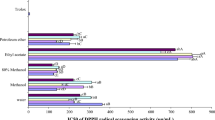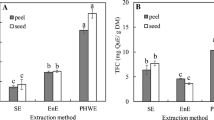Abstract
The present study investigated the effect of enzyme pre-treatment on extraction of active compounds from spices, namely, black pepper and cardamom. A mixture of enzymes, namely, Lumicellulae (a mixture of cellulase, β-glucanase, pectinase, and xylanase), was used for the pre-treatment of black pepper and cardamom. The pre-treatment of spices with enzyme increased the yield of essential oil. The GC and GC-MS evaluation of the essential oil showed that the major active components in spices, such as, β-caryophyllene in black pepper and α-terpenyl acetate in cardamom, markedly increased from 15.03 to 25.58 and 38.91 to 48.6%, respectively, on enzyme treatment as compared with the untreated control. The improvement in the yield and the major components of essential oil was attributed to the destruction of the cell wall structure by the enzymes pre-treatment which was substantiated with microscopical images using SEM.
Similar content being viewed by others
References
Sowbhagya HB, Srinivas P, Krishnamurthy N. Effect of enzymes on extraction of volatiles from celery seeds. Food Chem. 120: 230–234 (2010)
Shamala TR, Manonmani H, Venkateswaran G, Sowbhagya HB, Sampathu SR, Joseph R. An enzymatic process for the preparation of spice oil U.S. Patent WO/2005/063953 (2005)
Naidu MM, Sujith Kumar PV, Shyamala BN, Sulochanamma G, Prakash M, Thakur MS. Enzyme-assisted process for production of superior quality vanilla extracts from green vanilla pods using tea leaf enzymes. Food Bioprocess Technol. 5: 527–532 (2012)
Rui H, Zhang L, Li Z, Pan Y. Extraction and characteristics of seed kernel oil from white pitaya. J. Food Eng. 93: 482–486 (2009)
Zúñiga ME, Soto C, Mora A, Chamy R, Lema JM. Enzymic pretreatment of Guevina avellana mol oil extraction by pressing. Process Biochem. 39: 51–57 (2003)
Sowbhagya HB, Purnima KT, Florence SP, Rao AGA, Srinivas P. Evaluation of enzyme-assisted extraction on quality of garlic essential oil. Food Chem. 113: 1234–1238 (2009)
Lee EB, Shin KH, Woo WS. Pharmacological study in piperine. Arch. Pharm. Res. 7: 127–132 (1984)
Ravindran PN, Johny AK. Black pepper. pp. 74–80. In: Hand Book of Herbs and Spices. Peter KV (ed). CRC Press/Woodhead Publishing, Cambridge, UK (2001)
Ronald SK, Ronald S. Herbs spices and salts. pp. 394–414. In: Pearsons Chemical Analysis of Food. Addison-Wesley, Churchill Livingstone, New York, NY, USA (1981)
Gurudutt KN, Naik JP, Srinivas P, Ravindranath B. Volatile constituents of large cardamom (Amomum subulatum Roxb.). Flavour Frag. J. 11: 7–9 (1996)
ASTA. Official Analytical Methods of the ASTA. 4th ed. Method 5. pp. 1–55. American Spice Trade Association, Eagle Wood Cliffs, NJ, USA (1991)
NIST Library: Mass Spectral Data Base Parts 5990±90150 Associated with HPGC±MS. National Institute of Standards and Technology. Gathersburg, MD, USA (2011)
Adams RP. Identification of Essential Oil Components by Gas Chromatography/Quadrupole Mass Spectroscopy. Allured Publishing Corporation, Carol Stream, IL, USA (2001)
Davies NW, Gas chromatographic retention indices of monoterpenes and sesquiterpenes on methyl silicone and carbowax 20 M phases. J. Chromatogr. 503: 1–24 (1990)
Jennings W, Shibamoto T. Qualitative Analysis of Flavour and Fragrance Volatiles by Glass Capillary Gas Chromatography. Academic Press, New York, NY, USA. pp. 9–465 (1980)
Ramaswami SK, Briscese P, Gargiullo RJ, Geldern TV. Sesquiterpene hydrocarbons: From mass confusion to orderly lineup. In: Proceeding. 10th International Congress of Essential Oils, Fragrances and Flavours. pp. 951–959. Washington, DC, Elsevier Science Publications, Amsterdam, Netherlands (1986)
Sowbhagya HB, Srinivas P, Kaul TP, Krishnamurthy N. Enzymeassisted extraction of volatiles from cumin (Cuminum cyminum L.) seeds. Food Chem. 127: 1856–1861 (2011)
Dandjouma AKA, Tchiegang C, Kapseu C, Linder M, Parmentier M. Enzyme-assisted hexane extraction of Ricinodendron heudelotii (Bail) Pierre ex Pax seeds oil. Int. J. Food Sci. Tech. 43: 1169–1175 (2008)
Dominguez H, Nunez MJ, Lema JM. Enzyme assisted hexane extraction of soya bean oil. Food Chem. 54: 223–231 (1995)
Rouatbi M, Duquenoy A, Giampaoli P. Extraction of the essential oil of thyme and black pepper by superheated steam. J. Food Eng. 78: 708–714 (2007)
Murthy CT, Bhattacharya S. Cryogenic grinding of black pepper. J. Food Eng. 85: 18–28 (2008)
Plessi D, Bertelli F. Miglietta M. Effect of microwaves on volatile compounds in white and black pepper. LWT-Food Sci. Technol. 35: 260–264 (2002)
Variyar PS, Bandyopadhyay C, Thomas P. Effect of τ-irradiation on the volatile oil constituents of some Indian spices. Food Res. Int. 31: 105–109 (1998)
Marie EL, Jacqueline S, Bradshaw S, Louw W, Chemat F. Solvent free microwave extraction of Elletaria cardamomum L.: A multivariate study of a new technique for the extraction of essential oil. J. Food Eng. 79: 1079–1086 (2007)
Raghavan B, Shankaranarayana ML. Spices and spices products. pp. 55–82. In: Guide on Food Products. Ullas DL (ed). Spelt Trade Publications, New Bombay, India (1992)
Dourado F, Gama FM, Mota M. Effect of enzyme treatment on the cell wall microstructure of G. avellana seeds, optical microscopy, and granulometric studies. Pol. J. Food Nutr. Sci. 48: 69–72 (1998)
Sineiro J, Dominguez H, Nunez MJ, Lema JM. Microstructural features of enzymatically treated oil seeds. J. Sci. Food Agr. 78: 491–497 (1998)
Author information
Authors and Affiliations
Corresponding author
Rights and permissions
About this article
Cite this article
Chandran, J., Amma, K.P.P., Menon, N. et al. Effect of enzyme assisted extraction on quality and yield of volatile oil from black pepper and cardamom. Food Sci Biotechnol 21, 1611–1617 (2012). https://doi.org/10.1007/s10068-012-0214-y
Received:
Revised:
Accepted:
Published:
Issue Date:
DOI: https://doi.org/10.1007/s10068-012-0214-y




